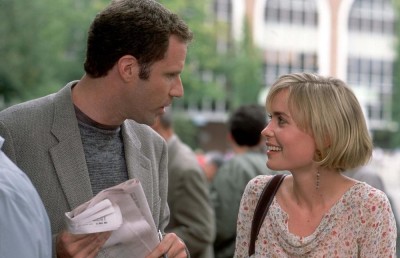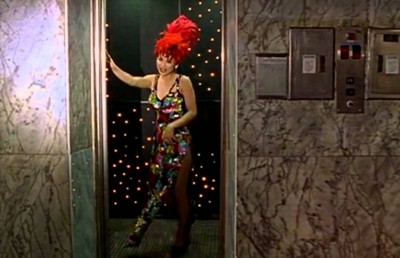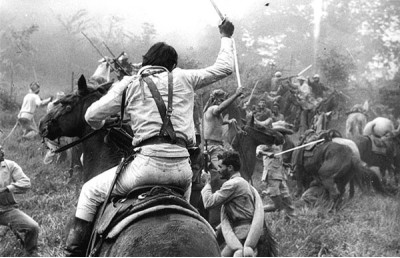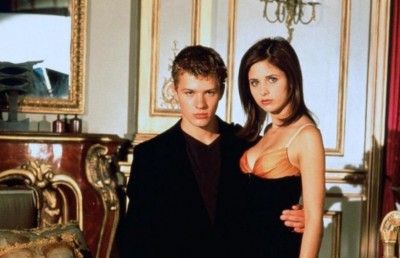The Mondo Film: Bizarre Rituals and Steamy Nights
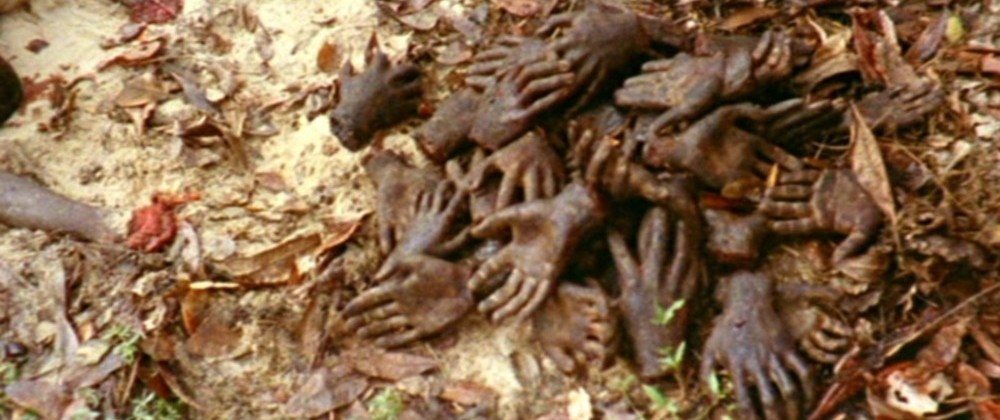
It’s the beginning of the 1960’s. At Castellaneta, Italy, birthplace of Rudolph Valentino, young men partake in strange rituals commemorating their idol. In New Guinea, young sex-seeking girls chase after men, much like their Western counterparts cruising the Riveria in body-revealing bikinis. In New York, restaurants specialize in a menu of sautéed butterflies, muskrats, stuffed beetles, and fried insects flavored in a variety of sauces. In the streets of Hamburg, inebriated derelicts stroll about in the steamy, drunken atmosphere of the big city. Night has arrived and Hong Kong adolescents leave on their sampan to sell their virginity to the highest bidders. These are just a few scenes from Mondo Cane (1962), the first pseudo-ethnographic documentary which gave birth to a host of other films from the same genre, principally films “made in Italy.”
A little before Mondo Cane, his first feature film, journalist and noted playboy Gualtiero Jacopetti was victim of a car crash in California (of which he was apparently responsible) which took the life of British actress Belinda Lee and in which he himself was injured. Since that tragic event Jacopetti developed a fixed idea on the meaning of existence, one which postulates that each man harbors within himself an element of sadism. And that each spectator was simply a voyeur adapted to all forms of the bizarre. His mondo documentaries, filled with bizarre events to which spectators serve both passive and willing witnesses, are living proof of this belief. When Jacopetti is particularly inspired, the selection and articulation of the abject and sensationalist portraits reveal a splendor and lyricism worthy of interest (Mondo Cane). However, when the director gives way to his fatalist spirit, abjection and degradation, continuing to function on their own, almost become captivating (Women of the World/La donna nel mondo, 1963). But the ultimate goal of the mondo film is to capture the bizarre, the monstrous, and reveal the unknown and the forbidden. For this reason, should we consider Jacopetti as the veritable pioneer of a genre greatly adulated by the public and subject to numerous diatribes by the rare critics so inclined?
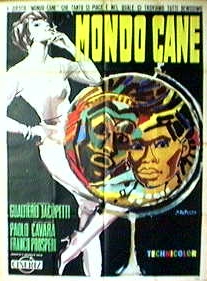
The Exotico-Folkloric Documentary
In the domain of the documentary, the line which links the neorealist films of the 1940’s and 1950’s to the 1960’s is evident in such films as L’amore in citta (Love in the City, 1953), directed by Michelangelo Antonioni, Francesco Maselli, Federico Fellini, Alberto Lattuada, Carlo Lizzani and Nelo Risi under the benevolent tutelage of Cesare Zavattini; or Le Italiane et l’amore, (1961) by Gian Vittorio Baldi, Marco Ferreri, Giulio Macchi, Francesco Maselli, Gianfranco Mingozzi, Lorenza Mazzetti, Carlo Musso, Piero Nellin, Giulio Questi, Nelo Risi and Florestano Vancini. In a sense, these two documents (fictionalised) attempted to recall some themes that were dear to neo-realism: history and social reality. The approach is no longer documentary. Fiction joins reality in an amalgamation of played drama and detailed inquiry.
However, this period also saw the birth of the exotico-folkoric documentary which, without delay, became successful by exploiting controversial subjects and clandestine ethnography. These two spectacular aspects attracted a credulous public and gave them the illusion of exploring certain bizarre customs that are abundant in our civilisation. In 1955 five people (Leonardo Bonzi, Mario Craveri, Francesco A. Lavagnino, Enrico Gras and Giorgi Moser) inaugurate the series with Continente perduto (Lost Continent, 1954). Curiously, this travesty of a documentary won the Special Critics prize at the Cannes Film Festival. The film was followed by Magia Verde (Green Magic, 1954) and L’impero del sole (Empire in the Sun, 1955), the second and third parts of the trilogy. If in this era we see a new genre appearing in Italy, that of the documentary feature, it falls within the flashy and the picturesque as well as the superficial and the false.
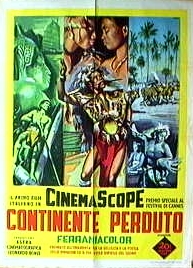
At its peak, the mondo film attracted a mainly male audience whose principal interest was in seeing shocking imagery consistently fed by the theme of the forbidden. These same spectators were equally willing to accept the staginess and artificiality of a product that still managed to excite the senses.
In the decade from 1959 to 1969 more than 100 of these films invaded the theatres of the world. Additionally, it is in this same spirit of exploitation, often excessive, that the following films were created: Mondo di Notte No. 3 (Ecco, 1963) by Gianni Proia, Mondo Balordo (1964) by Roberto Bianchi Montero, Questo Mondo proibito (The Forbidden World, 1963), Mondo infame (This Vile World) by Montero, Mondo nudo (Naked World, 1963) by Franceso de Feo and also Le città proibite (The Forbidden Cities), Macabro, Tabu (The Taboos of the World), and dozens of others. At this point in time the genre was in its moment of glory, but the critics barely took notice, not even from a sociological standpoint. The serious critics banished the genre and never really understood the passion of those who presented themselves at the ticket booth to discover the mystery of each new film. For example, with the case of the film Il Pelo nel Mondo (Go! Go! Go! World, 1964) the critics of the OCFC (The Catholic Film Office of France) declared in one of its Cinema Files of 1964 that “a film so debased should not only be restricted to people over 18 years of age; it should also be rejected by anyone with even a modicum of self-respect and by all nations that refuse contaminated and rotten merchandise.” Contrary to many other popular genres, the mondo cinema is totally absent from the criticism and analysis of all theorists and historians of cinema. Nevertheless, the term mondo is found in the title of numerous productions in which the subject has nothing to do with the documentary. Some examples: Mundo depravados (drama of social mores), Mondo Sexo (light comedy), Mondo Weirdo (drama of social mores), Mondo Keyhole (horror drama), and Mondo Trasho (comic satire). In another sense of the idea, if the Italian directors remain the inventors of the genre, certain other directors dared risk everything to imitate their transalpine brothers. Prostitutes, strip teasers and scenes of orgy are filmed (or staged?) by the American director Lee Frost in Hollywood’s World of Flesh (1963). In the same year, Mitchell Leisen, Walon Green, P. Hal Roach, and Carroll Chase show cock fights, a Jayne Mansfield striptease, Juliet Prowse as Cleopatra doing a lascivious dance (the actress/dancer tried to later sue the film’s producers, with reason) and other oddities, in Las Vegas by Night (1967). Even the Japanese were interested in the genre. A certain Tetsuji Takechi pointed his camera lens at masseurs, drug addicts, and others (at that time) perversities in Tetsuji’s Onna Onna Onna Monogatari (Women…Oh, Women!, 1963).
Claude Lelouch flirts with the genre with La Femme Spectacle (1964). As a starting point, he presents female spectacle across the world. It is here that we witness prenatal exercises and a child birth, without forgetting of course, the striptease sequences and the scenes with the transvestites and transsexuals. Filmed in black and white, this strange film (banned in France in its initial release) ends with an intrusive transition to color cinemascope: from atop the Eiffel Tower we witness the suicide attempt of a young woman dressed in a wedding gown. It should be noted that Lelouch destroyed the negative himself a short while later. In 1966 Lee Frost picks up the torch with Mondo Freud And Russ Meyers proposes Mondo Topless (of which some scenes where taken from his Europe in the Raw, directed three years earlier).
The mondo film of the 1960s was, despite itself, an innocently provocative genre. The majority of these films wanted to denounce, expose and educate, notwithstanding the sometimes hypocritical moralizing. However, hidden behind these noble intentions was an economic interest insured by the growing popularity of a genre inexorably doomed for failure.
The mondo continued its path in the 1970s, 1980s and 1990s oscillating, as always, between documentary and fiction, the true and the false, the artificial and the original. Films like Shocking Asia (Rolf Olsen, 1974), Sex O’clock U.S.A. (François Reichenbach, 1976) and the trilogy This is America (Romano Vanderbes, 1977) or The Forbidden World (Les Interdits du monde, Chantal Lasbats, 1986?) are examples that no longer convinced, models a notch below their predecessors from the 1960s. Clearly, the spirit was missing.
It would be impossible to make these type of films for the big screen today. The ridiculous Quebecois film Mondo Montréal (Vincent Ciambrone, 1991) did not have the success expected. There is a film entitled Montréal clandestin but it was never released theatrically (and can be found on video). Sensationalism can now be regularly found on our television screens, with such shows as The Jerry Springer Show, where pre-selected guests unveil their personal problems in front of a live studio audience. The influence of mondo is evident in other television shows such as Santé et société, 60 Minutes, Les Grands Reportages, and even the television series National Geographic. Video retail outlets (and not necessarily the specialized ones) offer collections of videos and DVDs featuring graphic automobile accidents, the most horrible capital punishments, and even snuff movies (films which purport to include real, on-screen human torture and death): Traces of Death (1994), Death Scenes (1992), The Shocks (1987), and Executions (1995) are a sampling among many.
Sexy by Night
A variation on the mondo film was the “sexy nocturne,” films which exploited female nudity by situating it within a cultish context. Approximately 100 of such films were produced from 1959 to 1970. The francophone countries were the most enthusiastic audiences for the “sexy nocturne.”
The genre was born in Italy with a formula that its creators referred to as the sexy documentary. Alessandro Blasetti got the ball rolling in 1959 with Europa di notte (European Nights) and Io Amo, tu ami (I Love, You Love), proposing to the spectators all that the market of the superfluous and voluptuous could offer. But on close analysis one realizes that the films proceed with a structure that is practically ancient. Like cinema at its birth, the structure attaches itself to the tradition of the fairground spectacle: cabaret and music hall scenes are filmed in their entirety. Like one would expect, nudity dominates and sexuality becomes an exhibition object. However, unlike the naturalist films (nudies) of the 1950s which were marked by the seal of spirituality and ecology, nudity is reclaimed here as an art and profession. The strip teasers being filmed are real dancers. The female sex organ becomes the focal point of the image, capturing the spectator’s eye who imagines a thousand and one fantasies because, despite the strip teasing, the unveiled body still retains an air of mystery.
For the first time, popular cinema renders the female sex organ manifest, although still hidden by a G-string. Fixed on its trestle and in the center of the shot, the mythical object organizes around itself a ritualistic dance marked by a series of sensual and haunting movements. Nudity is no longer a natural situation, but simply a curiosity for the eye, constantly and deliciously teased by the sensual drunkenness she arouses.
The “sexy nocturne” becomes easily identifiable, with titles that contain such key words as: women, girls, world, night, and sexy. Out of this arises: Mondo di notte (The World by Night), Sexy al neon, Mondo sexy di notte, Mondo caldo di notte, I piaceri nel mondo, Canzoni di tutto il mondo, Mondo di notte 2, Veneri proibiti, Universo proibito, Sexy ad alta tensione, and many other documentary attractions. As an aside, the actor Franco Interlenghi ventured into the genre as a producer in 1962 with Universo di notte, which starred his Italo-Lebanese wife Antonella Lualdi.
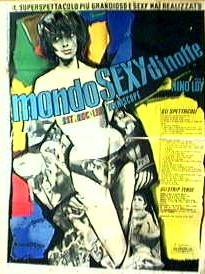
On the one hand these reportings on nocturnal lifestyle operate within the pretext of cultural exploration, but the voice-over commentary immediately reveals the true intentions of the filmmakers. The spectator knows right away what awaits them. For example, in Notti calde d’Oriente (Orient by Night, 1962) by Roberto Bianchi Montero, the first images are purely touristic (we are in front of the Egyptian Pyramids). The narrator cites two oriental proverbs which state, “A man without a woman is like a cart without a horse going along a road leading to nowhere,” or better yet, “It is preferable to live one year with seventy women, than seventy years with one woman.” Suddenly, a straight cut transports us to the heat of the Oriental nights (Cairo, or perhaps Lebanon). The multicolored neon signs sparkle a thousand and one lights. At this moment the commentary becomes more eloquent: “Our fabulous voyage across these scorching Oriental nights carries us within these people who jealously guard within their hearts the cult of the female beauty….and each time, or nearly, we see love transform itself into a frenetic pagan ritual.”
Sometimes these night time reportages are full of falsehoods because they are often fabricated (are we really in Paris, London, Madrid or Hamburg?). The studios of Rome or Milan have often served as locations for the staging of nude scenes.
If at the beginning the “sexy nocturne” displayed, outside of the strip teasers, charming singers and music hall spectacles (ventriloquists, marionettes, acrobats, prestidigitators….), little by little, the striptease soon takes over and constitutes the principal attraction of the films.
During this era the striptease has its beauty queens and develops its own form of star system. Beautiful, sculptural, and with impeccable bodies, these dancers of desire and veritable enchanters, have names like Lady Chinchilla, Rita Hymalaya, Rafa Temporel, Dodo d’Hamburg, Poupée la Rose, Bonita Super, Véronique, Truda, Lova Moor, Bettina Uranium, Sofia Palladium, and Rosa Fumetto. When the mise en scene is not faked, they are filmed direct in the Crazy Horse and the Sexy Club in Paris, and other hot night spots around the world.
However, the nudity had its limits which stopped at slips, panties, and tiny star-shaped decorations at the tip of the breasts, and G-strings. Sometimes, urged by the presence of the camera, the audacity went further, to the great pleasure of the audiences who awaited such moments with great anticipation, without a doubt with more tension toward the unveiling of the body than in front of the most daring of X-rated shows. Because in the “sexy nocturne,” the sexual metaphor makes unquestionable reference to an extra-cinematographic object which supersedes all forms of representation. The made-up and powdered skin of the dancers forms an exterior shell. In addition, the mise en scene protects the same skin from the spectatorial gaze. Although hoped for, the close-up is rare. The body is often bathed in red, blue, and yellow colors and lighting which evoke the scorching glow of hell, forming an impenetrable yet quasi-seductive space. The female, dancers of desire and sensuality, also manipulate the situation. The spectator remains passive in her illusory pleasure. The female nude is no longer a sex object. She becomes, simply put, desire. The “sexy nocturne” was presented in this way in the 1960s.
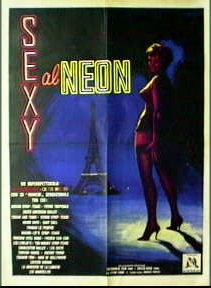
The genre no longer exists for reasons which would seem apparent to us today. A change in the direction of erotic cinema has seen its evolution transferred into a cinema of pornography, a genre where bodies conjoin, more often without emotion or actual sensuality: the man remains dominant and the woman the sexual object to be dominated. Desire is absent. In another sense, there is dissatisfaction for cabaret-style attractions, replaced by spectacles that are less kitsch and flashy (often broadcast on specialty television stations). Above all, we are especially witness to certain results of female liberation. Paradoxically, women reject their ancient status of mythical object, but also (due to freedom of expression) denounce the censure of certain forms of expression of pornography. The most intimate manifestation of sexuality (erotica) has become a commodity, losing its sense of mystery and its multiple delights.
This essay orignally appeared in French in Séquences #197 (July-August 1998): 27-30. It has been translated by Donato Totaro.


